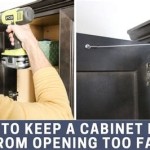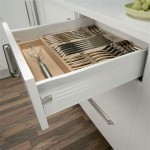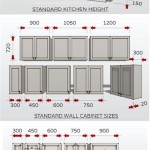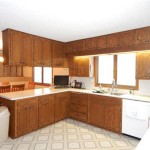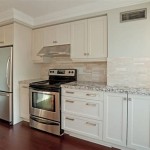Is It Easy To Install Kitchen Cabinets? A Detailed Examination
Kitchen cabinet installation is a common home improvement project. The perception of its difficulty varies widely, often depending on an individual's prior experience, skill level, and the complexity of the cabinet design and kitchen layout. While seemingly straightforward in principle, the process involves several steps that require precision, attention to detail, and fundamental knowledge of carpentry and construction techniques.
A critical distinction exists between replacing existing cabinets in a similar configuration and installing cabinets in a completely new kitchen space. Replacement is generally considered easier, as the underlying infrastructure, such as plumbing and electrical wiring, is already in place. However, even replacement projects can present challenges, particularly if the new cabinets are not perfectly sized or aligned with the existing features.
New kitchen cabinet installations are inherently more complex. They necessitate meticulous planning, including accurate measurements, careful consideration of appliance placement, and strategic layout design. Furthermore, new installations may involve modifications to the existing structure, such as moving electrical outlets or plumbing lines, which significantly increases the project's difficulty.
Factors Influencing Installation Difficulty
Several factors contribute to the perceived difficulty of kitchen cabinet installation. These factors encompass the installer's technical skills, the characteristics of the cabinets themselves, and the specific attributes of the kitchen space.
Skill Level and Experience: An individual's proficiency in carpentry, familiarity with power tools, and understanding of basic construction principles are paramount. Experience in similar projects, such as installing shelving or building furniture, can be highly beneficial. Conversely, a lack of these skills may result in errors, wasted materials, and a less-than-satisfactory outcome.
Cabinet Type and Construction: The type and construction of the cabinets themselves also play a significant role. Ready-to-assemble (RTA) cabinets, while often more affordable, require assembly, which can be time-consuming and potentially confusing. Custom or semi-custom cabinets, which are often pre-assembled, may simplify the installation process but typically carry a higher price tag. The materials used in the cabinet construction, such as solid wood, plywood, or particleboard, can also affect the installation. Solid wood cabinets tend to be heavier and more durable, while particleboard cabinets are lighter but may be more susceptible to damage.
Kitchen Layout and Existing Conditions: The layout of the kitchen, including the presence of corners, islands, and soffits, can significantly impact the installation process. Uneven walls, floors, or ceilings can also pose challenges, requiring shimming and adjustments to ensure that the cabinets are level and plumb. Pre-existing conditions, such as outdated plumbing or electrical wiring, may need to be addressed before the cabinets can be installed, further complicating the project.
Steps Involved in Kitchen Cabinet Installation
A successful kitchen cabinet installation requires a systematic approach, involving several key steps, each demanding precision and attention to detail. While the specific steps may vary depending on the project's scope and complexity, the following outlines the fundamental stages involved.
Planning and Preparation: The first step involves meticulous planning, which includes creating a detailed kitchen layout, taking accurate measurements, and selecting the appropriate cabinets and hardware. This stage also involves checking for level and plumb walls and floors, and identifying any potential obstacles, such as plumbing lines or electrical wiring. The homeowner or installer needs to obtain necessary permits if required by local building codes. Ensure all necessary tools are readily available and in good working condition. This includes a level, stud finder, drill, screwdriver, measuring tape, and safety gear.
Demolition (If Applicable): If replacing existing cabinets, the old cabinets must be carefully removed. This may involve disconnecting plumbing and electrical fixtures, removing doors and drawers, and detaching the cabinets from the walls. It is crucial to proceed carefully to avoid damaging the walls, floors, or existing utilities. Proper disposal of the old cabinets and associated debris is also necessary.
Wall Preparation: After removing the old cabinets, the walls should be thoroughly inspected and prepared. This may involve patching any holes or cracks, sanding down uneven surfaces, and applying a fresh coat of paint or primer. Addressing these issues before installing the new cabinets ensures a smooth and even surface for attachment.
Locating Studs: Accurately locating wall studs is crucial for securely attaching the cabinets. A stud finder can be used to identify the location of the studs behind the drywall. Mark the stud locations clearly on the wall to ensure that the screws or fasteners are driven directly into the studs.
Installing the Upper Cabinets: Typically, the upper cabinets are installed first. Begin by establishing a level line on the wall to serve as a guide for the top of the cabinets. Use a ledger board, a temporary support structure, to hold the cabinets in place while attaching them to the wall studs. Secure the cabinets to the studs using screws or fasteners of appropriate length. Ensure the cabinets are level and plumb before tightening the screws.
Installing the Lower Cabinets: After the upper cabinets are installed, proceed with the lower cabinets. Begin by locating the high point in the floor. Lower cabinets are usually installed level to that high point. Use shims to level the cabinets as needed. Secure the cabinets to the wall studs using screws or fasteners. Connect adjacent cabinets together using screws or clamps to ensure a seamless and uniform appearance.
Installing Countertops: Once the cabinets are installed, the countertops can be installed. The process varies depending on the type of countertop material. Some countertops, such as laminate, can be installed by the homeowner, while others, such as granite or quartz, typically require professional installation. Ensure the countertops are properly supported and sealed to prevent water damage.
Installing Hardware and Finishing Touches: The final step involves installing the hardware, such as knobs, pulls, and handles. Adjust the cabinet doors and drawers to ensure they open and close smoothly. Install any trim or molding to conceal gaps or imperfections. Clean up the work area and remove any debris.
Potential Challenges and Common Mistakes
Even with careful planning and execution, kitchen cabinet installation can present various challenges and pitfalls. Recognizing these potential issues can help homeowners or installers avoid costly mistakes and ensure a successful outcome.
Inaccurate Measurements: Taking inaccurate measurements is one of the most common mistakes in kitchen cabinet installation. Even a slight error can lead to significant problems, such as cabinets that don't fit properly or gaps between cabinets and walls. It is crucial to double-check all measurements and account for any irregularities in the walls or floors.
Failure to Level and Plumb: Failing to properly level and plumb the cabinets can result in cabinets that are visually unappealing and structurally unsound. Using a level and shims is essential to ensure that the cabinets are perfectly aligned. Neglecting this step can lead to doors and drawers that don't close properly and countertops that are uneven.
Improper Fastening: Using the wrong type or size of screws or fasteners can compromise the stability of the cabinets. It is crucial to use screws or fasteners that are appropriate for the type of wall material and the weight of the cabinets. Failing to secure the cabinets properly to the wall studs can lead to them pulling away from the wall over time.
Damaging Existing Utilities: Drilling into plumbing lines or electrical wiring can result in serious damage and potential safety hazards. Before beginning the installation, carefully identify the location of these utilities and take precautions to avoid damaging them. If necessary, consult with a qualified plumber or electrician to relocate or modify these utilities.
Incorrect Order of Installation: Proceeding with the installation in the wrong order can make the process more difficult and time-consuming. Typically, the upper cabinets are installed before the lower cabinets, and the countertops are installed after the cabinets are in place. Deviating from this order can lead to problems with alignment and accessibility.
Lack of Necessary Tools: Attempting to install kitchen cabinets without the proper tools can lead to frustration and substandard results. Ensure all necessary tools are readily available and in good working condition before beginning the project. Rent or borrow any specialized tools that are not commonly owned.
Ignoring Building Codes: Failing to comply with local building codes can result in fines and delays. It is crucial to research and understand the relevant building codes before beginning the installation. Obtain the necessary permits and inspections to ensure that the project meets all applicable requirements.
By understanding the complexities involved, acknowledging the potential challenges, and preparing appropriately, individuals can make an informed decision about whether to undertake kitchen cabinet installation as a DIY endeavor or to engage the services of a professional installer. A realistic assessment of one's skills, combined with careful planning and execution, will contribute significantly to a successful and satisfying outcome.
How To Install Kitchen Cabinets Diy Family Handyman
How To Install Kitchen Cabinets Diy Family Handyman
Here S How Install New Upper Kitchen Cabinets
How To Install Cabinets Diy Or Hire A Pro Flippers Warehouse
How To Install Kitchen Cabinets And Remove Them Remodel Pt 1 Crafted Work
How To Install Kitchen Cabinets In 5 Steps The Rta
Kitchen Cabinet Installation Ep 120
How To Install Base Cabinets The Home Depot
How To Install Kitchen Wall And Base Cabinets Builder Supply
How To Install Kitchen Cabinets The Home Depot
Related Posts

